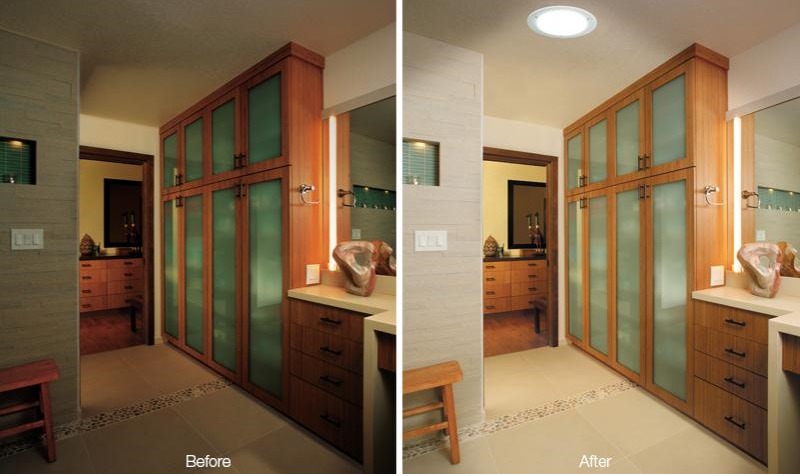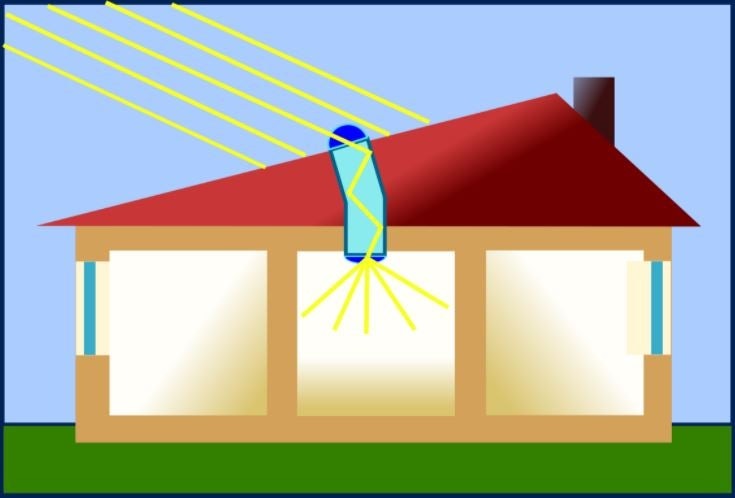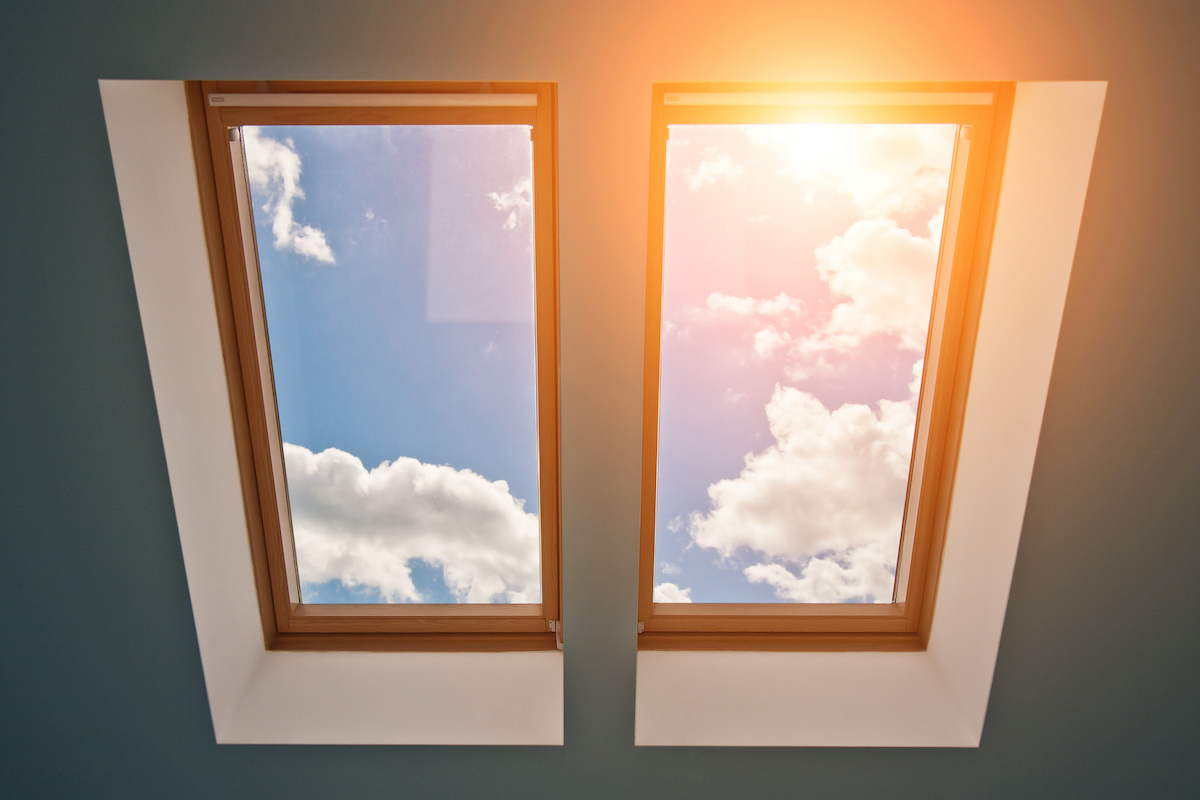Updated 1 week ago
Solar tubes: Everything you need to know
Written by Dan Hahn Dan HahnDan is a solar journalist and content advisor with SolarReviews. He also works with solar installers and solar nonprofits to develop and execute strat...Learn more

Why you can trust SolarReviews
SolarReviews is the leading American website for solar panel reviews and solar panel installation companies. Our industry experts have a combined three decades of solar experience and maintain editorial independence for their reviews. No company can pay to alter the reviews or review scores shown on our site. Learn more about SolarReviews and how we make money.
Solar tubes bring daylight into your home in one of the most enjoyable and simplest ways. The light shines on a clear acrylic dome on your roof, which is attached to a reflective metal tube that runs to an interior ceiling. A solar tube can be anywhere from 10 to 22 inches wide, and provides lots of natural sunlight, even on cloudy days.
Solar tubes offer some significant advantages compared to traditional skylights. They’re less expensive and easier to install, and they prevent the kind of heat loss (and gain) that can come with a full-sized window in your roof.
On the other hand, there are a few drawbacks. A solar tube doesn’t provide the same kind of expansive outdoor view as a skylight, and if you live in a northern climate, you might desire the heat gain a skylight can offer from wintertime sunshine.
Let’s dive a little deeper into how solar tubes function, how they compare to skylights, and which products make our list of top picks for your home.
What are solar tubes?
Solar tubes, also known as “sun tunnels”, “light tubes”, and “daylight pipes”, channel outside daylight into your home.
While they don’t allow for a nice view of the outside world, they do provide a natural, cost effective way to naturally illuminate dark interior spaces without using electricity.

On the left: a dark bathroom space before a solar tube installation. On the right, the same space with natural sunlight pouring in through a solar tube fixture. Image source: Bob Vila
Because they are relatively small, solar tubes can be easily placed between roof rafters. As a homeowner, that alleviates worry about the structural integrity of your roof. Compared to skylights, solar tubes minimize heat gains and heat losses.
They are a good choice for integrating daylight into small, dark spaces in your home such as hallways, laundry areas, closets, and bathrooms.
How do solar tubes work?
Solar tube heads are optically engineered to direct as much light as possible into the tunnel below and come in a variety of sizes which range from about 1 to 2 feet in diameter. They are usually protected with a clear, weather-resistant acrylic dome.

Image source: Wikipedia
The tube skylight piping length can be extended indefinitely, and is lined with a super-reflective “continuous mirror” coating to amplify the direct sunlight as it pours through to its target.
Most models offer a low-profile, flexible tubing which alleviates the hassle of cutting and fitting sheet metal, as you’d need to with rigid solar tube models.
Velux is the leading manufacturer of solar tubes. Their solar tube models look like small skylights embedded into the face of your roof instead of bulky domes. If sleeker aesthetics are important to you, they are worthy of your careful consideration.
Most sun tubes come with a UV ray protection system, either at the source of sunlight on your roof, or in the light diffuser at the end of the tube. This ensures the sunlight entering your home won’t cause adverse health effects or damage paintings or surfaces.
How much do solar tubes cost compared to traditional skylights?
Solar tubes can be installed for much less than skylights. On average, professionally installed solar tubes cost about $750 apiece. Skylights average $1500 to $2500, depending on size and installation complexity.
If you have skills, confidence, and time, you can purchase a DIY solar tube kit for about $300 and install them yourself. Be sure to check if you have a current roofing warranty from your roofing installer. If you attempt a solar tube install yourself, you may void it.
You’ll need a roof pitch angle between 3 x 12 inches and 20 x 12 inches (roughly 14° to 60°), as almost all the models aren’t engineered for flat roofs or extreme slopes.
Most solar tube kits are designed for asphalt shingle roofing material, though adapters are readily available which make installation on wood, metal, or tile roof types straightforward.
Do solar tubes really work? How do they compare to skylights?
Yes, solar tubes are a very effective lighting solution for dark interior spaces like laundry rooms.
However, solar tubes do have a mix of strong advantages and drawbacks when compared with skylights. We’ll cover them below.
Solar tubes pros and cons:
Pros | Cons |
|---|---|
Affordable | Limited views |
Easy installation | Limited passive solar heat |
Energy efficiency |
|
Little maintenance |
|
Environmental impact |
|
Pros of solar tubes vs. skylights
Cost savings
Solar tubes are especially practical if your home has a lot of attic space.
Instead of installing expensive header beams, new drywall, and skylights, you can pipe sunlight through a solar tube and get a similar lighting effect at a fraction of the cost.
Installation ease
Solar tube installation is relatively fast and simple.
Because they have a small footprint, solar tubes can be easily plopped into your roof, between rafters. Installing skylights is a more laborious task, requiring proper care be made to ensure roof structure integrity, while a large window is embedded into your roofing membrane.
Energy efficiency
Each solar tube outlet can be considered similar to a light fixture in your home.
By piping sunlight into a regularly used space like a dark dining room, there’s a significant energy bill savings from not having to have those lights burning.
Little maintenance required
When your skylights get caked in debris or bird poop, it’s difficult not to notice.
You’ll need to get up on your roof regularly to clean them off so you have a clear view. The curved design of the solar tube’s exterior heads makes it more difficult for the elements to settle on and obstruct sunlight from than traditional skylights.
Solar tubes are vacuum sealed and many offer condensation release features. Even if you live in an area with consistent high humidity, you need not be concerned about cleaning as regularly.
Environmental savings
Sunlight is a clean, renewable resource. Solar tubes reduce interior heat gains in the summer that come from a high overhead sun pouring in through a skylight. That means your air conditioning system doesn’t have to work as hard to cool off your home.
In the winter, heat also has a more difficult time escaping through a small solar tube than a large skylight. So, you can expect your heating costs to be less severe.
When you use solar tubes, you are not only saving money on your electric bill, you’re reducing your carbon footprint, as well.
Cons of solar tubes vs. skylights
No expansive view of the outside world
There’s nothing quite like being able to look up through a big window in your living room into a starry night sky, or getting lost in your thoughts while staring into slowly swirling cloud formations.

For either escape, skylights are going to allow you to more fully experience the glory of our natural surroundings than solar tubes will. That’s especially true if you have a vaulted ceiling to embed them in.
Limited passive solar heat
Skylights have an advantage over solar tubes in their ability to incorporate passive solar architecture into home heating efficiency.
A low winter sun streaming through southerly-oriented windows and skylights creates a miniature greenhouse effect - warming your home’s interior.
Passive solar designs can produce much more heat than can escape through the glass in the wintertime. Solar tubes are not large enough to create this effect.
The positive health effects of solar tubes and skylights
According to the National Institutes of Health, 42% of Americans are deficient in Vitamin D.
Every extra photon of natural sunlight in your home is an additional resource your skin can use to create more Vitamin D, which helps boost your immune system, mood, and musculoskeletal health.
Additionally, seasonal affective disorder is nothing to take lightly. Especially during dreary winter months, being in an environment with more sunlight can ease symptoms of depression, increase your energy, and help you feel better about yourself.
Both solar tubes and skylights help increase the amount of natural sunlight in your home and provide numerous health benefits.
What are the best solar tubes for my home?
Making a good choice for the right kind of solar tube for your home depends on a few factors.
If you’ve got multiple levels of home to brighten with more than one fixture per room, and you’re due for a roofing upgrade, we’d recommend larger, Energy Star-rated Sun Tunnel offerings from Velux. They come with a 20-year warranty and use heavy-duty metal materials. Their rigid, 14-inch diameter model replaces about 300 watts of light per tube outlet. That’s the equivalent of three 100-watt bulbs!
Some Velux models even include solar night light bulbs embedded in the tubes. While more expensive, night LED light solar tubes qualify for the federal 30% solar energy tax credit because there’s a small solar panel inside them. Installing these models can offer significant savings on your overall installation, while providing the added benefit of more light during the evening.
If you just need to brighten up a dark space with a smaller footprint, look into the affordable and simple-to-install Natural Light 10-inch tubular skylight, available from Amazon. It comes with instructions and recommendations for flashing based on your roof material.
Of note, Solatube was the pioneer in the sun tunnel market. Their products have been on the market for over 20 years. Their engineering team was so focused on the amount of light captured by their product, they have paid less attention to things like aesthetics and the quality of light delivered until recently.
They have devoted more energy to diffuser lenses to address that, but if you’re looking for a warmer, more refined light, consider installing Velux sun tunnels instead.
Final thoughts on solar tubes for your home
Solar tubes are an elegant, energy-efficient way to naturally brighten up dark areas in your home.
They are relatively easy to install for a fraction of the cost of skylights. Because you’re using natural light where a light fixture would have been, you’re saving a lot of money on electricity and reducing your carbon footprint simultaneously.
Natural light has a strong impact on health and mood, so the more you can harness into your home the better you’ll feel. While traditional skylights offer an unparalleled view of the sky, solar tube lights offer a practical, budget-friendly option to take full advantage of indirect light to create a warmer, natural environment in your home.
To see how solar tubes can be integrated into your home, connect with one of our partner installers.
Key takeaways
Solar tubes are a practical, affordable way to brighten small, dark interior spaces in your home.
Solar tubes average $750 for professional installation, much less than installing skylights ($1500-$2500). DIY kits are available for about $300.
Solar tubes are low maintenance, relatively easy to install, and are highly energy efficient compared to light fixtures.
Velux and Solatube models have been on the market for the longest amount of time, and both have positive reviews.
Velux models are sleeker, put off warmer light, and some are embedded with solar LED night lights.
Dan is a solar journalist and content advisor with SolarReviews. He also works with solar installers and solar nonprofits to develop and execute strategic plans. Dan Hahn founded residential solar energy information and policy resource, Solar Power Rocks, in 2007. As the site's chief architect and senior editor, he developed a national framework for evaluating the impact of residential solar energy policy. Possessed with a mission to communicat...
Learn more about Dan Hahn